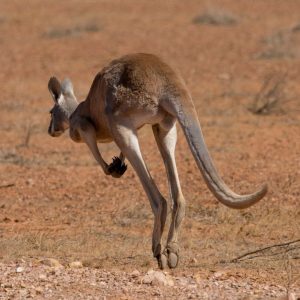It’s no secret that Australia is famous for its fauna. We are known all over the world for our unique wildlife, with animals such as wallabies and koalas charming would-be tourists and visitors, while, sadly, our snakes, spiders and “drop bears” have a less-positive reputation!
You might think, given the sometimes harsh climate, that wildlife may struggle to thrive in the Red Centre. In reality, Uluru-Kata Tjuta National Park alone is home to 21 native mammals, 73 types of reptiles and 178 species of birds, many of which you may sight on one of our exclusive tours. If you are interested in seeing some unique Australian wildlife, then make sure your first stop is the Red Centre – you’ll see some of the best Australia has to offer.
Kangaroos

Arguably Australia’s most famous animal, kangaroos (malu, in local Anangu language) can be found in various places around the country, although they generally don’t roam the city streets, unlike what some people overseas might think! Primarily, they are found on the plains and in open woodlands, but can also live in the desert or locations around the Red Centre. To avoid the sun or heat during the summer months, kangaroos are known to seek out a shady spot where they can spend most of their day.
As marsupials, kangaroos have a pouch where joeys reside and continue their postnatal development for at least six months following their birth. Interestingly, female red kangaroos are able to rear three young at once, with one joey free of the pouch, another developing in the pouch, and the third in utero. Additionally, they can hold back on giving birth for up to 11 months if a joey is still residing in the pouch!
Kangaroos can also cut a fairly impressive figure, with red male kangaroos growing up to 2.4 metres tall and weighing a maximum of 85kg. Female red kangaroos, however, are smaller, weighing up to 35kg, although they can still reach 2 metres in height. Altogether, this makes the red kangaroo Australia’s largest land mammal.
Culturally, kangaroos have long been of great importance to the Aboriginal people; the Anangu used parts of their body to bind hunting spears, while their meat was and remains a popular source of food. They also often feature in Indigenous art, as well as having a place in stories passed down through generations.
For those wanting to see some kangaroos, it’s important to know that their colouring allows them to blend into the sand and spinifex grass quite well, which, depending on their surroundings, can make them difficult to spot. However, our SEIT Mt Conner 4WD Outback Adventure tour, which offers you a chance to explore some unique environments, might give you a good chance of spotting some red kangaroos.
Dingoes

Even if you aren’t Australian, you may be familiar with dingoes or recognise their close relation to the domesticated dog. But while they resemble an animal you might have in your own home, it is important to remember that they are wild animals. For that reason, if you do happen to come across a dingo while touring the Red Centre, don’t try and pet them or offer food. Ordinarily, though, dingoes are wary of humans but are known to be inquisitive and observe from a safe distance.
Although there is no consensus on when the dingo first arrived in Australia, it is believed that they came here between 4000 to 8000 years ago and were initially found throughout the mainland. Unfortunately, the settlement of non-indigenous people had a negative impact on dingo numbers and spread, with the introduction of agriculture, poisons and land clearance resulting in their eradication in Victoria, much of New South Wales and parts of South Australia.
Like kangaroos, dingoes hold a place in Aboriginal culture, with their ancestral travels being described through a number of different accounts, such as appearing from the ground as rainbows. The Anangu people know them as papa.
Thorny Devils

One of Australia’s most distinctive creatures, the thorny devil (also known as Ngiyari) is designed for survival in the sometimes severe climate of the Red Centre. Their unique spikes create a channel that leads water directly into their mouth, meaning that any liquid, even dewdrops, can be easily gathered for them to drink. In terms of food, thorny devils have an extreme love of ants and are known to station themselves near an ant trail and eat thousands in a single day!
Thorny devils also have a few ways of concealing or protecting themselves from potential predators. Their curious way of walking, for instance – a slow rocking motion – is believed to bemuse birds of prey, while they can also change colour depending on their sun exposure or shifts in temperature, allowing them to blend into their surroundings. Furthermore, thorny devils actually have a knob on the back of their neck that acts as a “false head” to protect themselves. When threatened by predators, they are able to tuck their real head between their legs, resulting in their “false head” being presented for a potential attack.
Their small size also sometimes makes it hard to spy them in the outback, but our experienced guides will be sure to point them out for you if your tour happens to come across these spiky little creatures! On our SEIT Patji Cultural tour, you might even get close enough to take a few pictures, as we like to do – they’re one of our favourite lizards to photograph.
Blue-Tongue Lizards

It’s not hard to figure out why the blue-tongue lizard (otherwise known as lungkata) was given its name; watch them for a short while, and you’ll be sure to see their blue tongue dart from its mouth. Along with setting them apart from other lizards, the unique colour of their tongue is also important for their survival. When threatened, they flick their tongue out to scare off any would-be predators, such as hawks.
Uluru-Kata Tjuta National Park is actually home to two species of the lizard: the Centralian blue-tongue and the western blue-tongue. You might find them basking in a nice sunny spot in the area as, like all reptiles, they don’t produce body heat and rely on external heat sources to function properly. Additionally, like the thorny devil, blue-tongues are pretty slow movers and are good at camouflaging themselves to blend in with the desert and scrub. With that said, there is a fair chance you might spot one on our tour of Uluru-Kata Tjuta National Park!
The story of Lungkata, the greedy-blue tongue lizard who came to Uluru from the north, has been passed down for generations in Aboriginal culture, existing as a reminder of what happens to the greedy and dishonest. Ask your guide about it on your next SEIT tour; they might be able to tell you the whole story.
